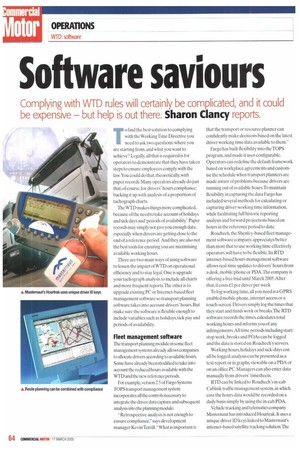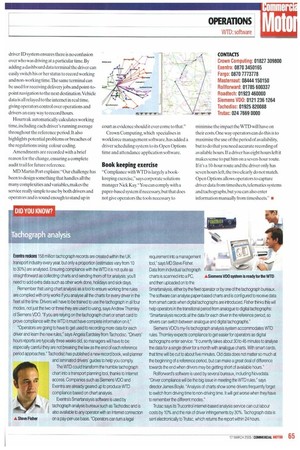Software saviours
Page 66

Page 67

If you've noticed an error in this article please click here to report it so we can fix it.
Complying with WTD rules will certainly be complicated, and it could be expensive — but help is out there. Sharon Clancy reports.
To find the best solution to complying with the Working Time Directive you need to ask two questions: where you are starting from, and what you want to achieve? Legally, all that is required is for operators to demonstrate that they have taken steps to ensure employees comply with the law. You could do that. theoretically, with paper records. Many operators already do just that, of course. for drivers' hours compliance; backing it up with analysis of a proportion of tachograph charts.
The WTD makes things more complicated, because of the need to take account of holidays and sick days and 'periods of availability'. Paper records may simply not give you enough data, especially when drivers are getting close to the end of a reference period. And they are also not the best tools for ensuring you are maximising available working hours.
There are two main ways of using software to lessen the impact of WTD on operational efficiency and to stay legal. One is upgrade your tachograph analysis to include all charts and more frequent reports.The other is to upgrade existing PC or Internet-based fleet management software so transport planning software takes into account drivers' hours. But make sure the software is flexible enough to include variables such as holidays, sick pay and periods of availability.
Fleet management software the transport planning module in some fleet management systems already allows companies to allocate drivers according to available hours. Some have already been modified to take into account the reduced hours available with the WTD and the new reference periods.
For example,version 2.5 of Fargo Systems TOPS transport management system incotporates all the controls necessary to integrate the driver data capture and subsequent analysis into the planning module.
"Retrospective analysis is not enough to ensure compliance," says development manager Kevin Terrill." What is important is that the transport or resource planner can confidently make decisions based on the latest driver working time data available to them."
Fargo has built flexibility into the TOPS program, and made it user-configurable. Operators can redefine the default framework based on workplace agreements and customise the schedule when transport planners are made aware of problems because drivers are running out of available hours.To maintain flexibility in capturing the data Fargo has included several methods for calculating or capturing driver working time information, while facilitating full historic reporting analysis and forward projections based on hours in the reference period to date.
Roadtech, the Shenley-based fleet management software company, appreciates better than most that to use working time effectively operators will have to be flexible. Its RTD intemet-based hours management software allows real-time updates to drivers' hours from a desk, mobile phone or PDA.The company is offering a free trial until March 2005. After that, it costs El per driver per week To log working time, all you need is a GPRS enabled mobile phone. intemet access or a touch-screen. Drivers simply log the times that they start and finish work or breaks.The RTD software records the times, calculates total working hours and informs you of any infringements.All time periods including start/ stop work, breaks and POAs can be logged and the data is stored on Roadtech's servers.
Working hours,holidays and sick-days can all be logged; analysis can be presented as a text report or in graphs, viewable on a PDA or on an office PC. Managers can also enter data manually from drivers' timesheets.
RTD can be linked to Roadtech's in-cab Cablink traffic management system, in which case the hours data would be recorded on a daily basis simply by using the in-cab PDA.
Vehicle tracking and telematics company Masternaut has introduced Hourtrak. It uses a unique driver ID keys linked to Mastemaut's intemet-based satellite tracking solution.The
driver ID system ensures there is no confusion over who was driving at a particular time. By adding a dashboard data terminal the driver can easily switch his or her status to record working and non-working time.The seine terminal can be used for receiving delivery jobs and point-topoint navigation to the next destination. Vehicle data is all relayed to the internet in real time, giving operators control over operations and drivers an easy way to record hours.
Hourtrak automatically calculates working time, including each driver's running average throughout the reference period. It also highlights potential problems or breaches of the regulations using colour coding.
Amendments are recorded with a brief reason for the change, ensuring a complete audit trail for future reference.
MD Martin Port explains:"Our challenge has been to design something that handles all the many complexities and variables,makes the service really simple to use by both drivers and operators and is sound enough to stand up in court as evidence should it ever come to that."
Crown Computing, which specialises in workforce management software, has added a driver scheduling system to its Open Options time and attendance application software.
Book keeping exerdse
"Compliance with WTD is largely a bookkeeping exercise," says corporate solutions manager Nick Kay. "You can comply with a paper-based system if necessary,but that does not give operators the tools necessary to minimise the impact the WTD will have on their costs. One way operators can do this is to maximise the use of the period of availability, but to do that you need accurate recording of available hours. If a driver has eight hours left it makes sense to put him on a seven-hour route. If it's a 10-hour route and the driver only has seven hours left, the two clearly do not match. Open Options allows operators to capture driver data from timesheets, telematics systems and tachographs, but you can also enter information manually from timesheets." •










































































































































































































